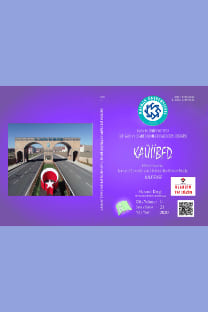YABANCI EL SENDROMU MU ÇİFT YÖNLÜLÜK MÜ? START-UPLAR ÜZERİNE ÇOKLU ÖRNEK OLAY ÇALIŞMASI
Örgütsel çift yönlülük, Start-uplar, Yabancı el sendromu
ALIEN HAND SYNDROME OR AMBIDEXTERITY? MULTIPLE CASE STUDY ON START-UPS
Organizational ambidexterity, Start-ups, Alien hand syndrome,
___
- Aldianto, L., Anggadwita, G., Permatasari, A., Mirzanti, I. R., & Williamson, I. O. (2021). Toward a Business Resilience Framework for Startups. Sustainability, 13(6), 1-19.
- Alina, B. (2011). Start-up financing sources: Does gender matter? Some evidence for EU and Romania. The Annals of the University of Oradea, 207, 644-9.
- Balboni, B., Bortoluzzi, G., Pugliese, R., & Tracogna, A. (2019). Business model evolution, contextual ambidexterity and the growth performance of high-tech start-ups. Journal of Business Research, 99, 115-124.
- Biran, I., Giovannetti, T., Buxbaum, L., & Chatterjee, A. (2006). The alien hand syndrome: What makes the alien hand alien?. Cognitive Neuropsychology, 23(4), 563-582.
- Birkinshaw, J. M., & Gibson, C. (2005). The ambidextrous organization. Advanced Institute of Management Research, Birmingham, UK.
- Birkinshaw, J., Zimmermann, A., & Raisch, S. (2016). How do firms adapt to discontinuous change? Bridging the dynamic capabilities and ambidexterity perspectives. California Management Review, 58(4), 36-58.
- Braun, V. & Clarke, V. (2006). Using thematic analysis in psychology. Qualitative Research in Psychology, 3, 77-101.
- Cao, Q., Gedajlovic, E., & Zhang, H. (2009). Unpacking organizational ambidexterity: Dimensions, contingencies, and synergistic effects. Organization Science, 20(4), 781-796.
- Cho, M., Bonn, M. A., & Han, S. J. (2020). Innovation ambidexterity: balancing exploitation and exploration for startup and established restaurants and impacts upon performance. Industry and Innovation, 27(4), 340-362.
- Creswell, J.W. (2007). Oualitative Inquiry&Research Design Choosing Among Five Approaches. 2nd Edition. London: Sage Publications.
- Du, W., Pan, S. L., & Zuo, M. (2013). How to balance sustainability and profitability in technology organizations: An ambidextrous perspective. IEEE Transactions on Engineering Management, 60(2), 366-385.
- Global Entrepreneurship Monitor (GEM) (2021). 2020/2021 Global Report. Global Entrepreneurship Research Association, London.
- Jansen, J. J., Van den Bosch, F. A., & Volberda, H. W. (2005). Exploratory innovation, exploitative innovation, and ambidexterity: The impact of environmental and organizational antecedents. Schmalenbach Business Review, 57(4), 351-363.
- https://evrimagaci.org/yabanci-el-sendromu-bilincimiz-gercekten-ozgur-mu-666, Erişim Tarihi: 12.05.2021
- Klein, M., Neitzert, F., Hartmann-Wendels, T., & Kraus, S. (2019). Start-up financing in the digital age–a systematic review and comparison of new forms of financing. The Journal of Entrepreneurial Finance, 21(2), 46-98.
- Korpysa, J. (2021). Process ambidexterity in startups innovation. Management Systems in Production Engineering, 29 (1), 27-32.
- March, J. G. (1991). Exploration and exploitation in organizational learning. Organization Science, 2(1), 71-87.
- Müller, E., & Zimmermann, V. (2009). The importance of equity finance for R&D activity. Small Business Economics, 33(3), 303-318.
- O'Reilly III, C. A., & Tushman, M. L. (2011). Organizational ambidexterity in action: How managers explore and exploit. California Management Review, 53(4), 5-22.
- O'Reilly III, C. A., & Tushman, M. L. (2013). Organizational ambidexterity: Past, present, and future. Academy of Management Perspectives, 27(4), 324-338.
- Panikkath, R., Panikkath, D., Mojumder, D., & Nugent, K. (2014). The alien hand syndrome. Baylor University Medical Center Proceedings, 27 (3), 219-220.
- Passaro, R., Quinto, I., Rippa, P., & Thomas, A. (2020). Evolution of Collaborative Networks Supporting Startup Sustainability: Evidences from Digital Firms. Sustainability, 12(22), 9437.
- Petru, N., Pavlák, M., & Polák, J. (2019). Factors impacting startup sustainability in the Czech Republic. Innovative Marketing, 15 (3), 1-15. Raisch, S., & Birkinshaw, J. (2008). Organizational ambidexterity: Antecedents, outcomes, and moderators. Journal of Management, 34 (3): 375-409.
- Raisch, S., Birkinshaw, J., Probst, G., & Tushman, M. L. (2009). Organizational ambidexterity: Balancing exploitation and exploration for sustained performance. Organization Science, 20 (4), 685-695.
- Schilling, M. A. (2019). Strategic management of technological innovation. McGraw-Hill Education.
- Schreuders, J., & Legesse, A. (2012). Organizational ambidexterity: How small technology firms balance innovation and support. Technology Innovation Management Review, 2(2), 17-21.
- Sinha, S. (2015). The exploration–exploitation dilemma: A review in the context of managing growth of new ventures. Vikalpa, 40(3), 313-323.
- Sorum, H.. (2013). Clinical Trials, Innovation and Approaches to Ambidexterity in Pharmaceutical Startup Companies. Master's thesis. University of Oslo.
- Stucki, T. (2014). Success of start-up firms: The role of financial constraints. Industrial and Corporate Change, 23(1), 25-64.
- Tushman, M. L., & O'Reilly III, C. A. (1996). Ambidextrous organizations: Managing evolutionary and revolutionary change. California Management Review, 38(4): 8-29.
- Vishwanath, K. R. (2018). An empirical examination of startup success: Studies on the antecedents and consequences of startup relational embeddedness and technology ambidexterity. Doctoral dissertation, University of Wisconsin—Whitewater.
- Volery, T., Mueller, S., & Von Siemens, B. (2015). Entrepreneur ambidexterity: A study of entrepreneur behaviours and competencies in growth-oriented small and medium-sized enterprises. International Small Business Journal, 33(2), 109-129.
- Xu, C. (2019). How do startups integrate strategies to achieve ambidexterity? Evidence from the Chinese education-technology industry. Doctoral dissertation. Michigan Ross.
- Yin, R.K. (2002). Case Study Research Design and Methods. 3rd Edition. London: Sage Publications.
- Zhang, S. X., Pertuze, J., & Carrasco, J. A. (2019). From A Blank Slate to Ambidexterity. Working Paper.
- ISSN: 1309-4289
- Yayın Aralığı: 2
- Başlangıç: 2010
- Yayıncı: Kafkas Üniversitesi, İktisadi ve İdari Bilimler Fakültesi
THE ROLE OF SOCIAL NETWORKS IN FOREIGN DIRECT INVESTMENTS: THE CASE OF TURKISH BUSINESS GROUPS
Elif SİS ATABAY, Tuğba KAPLAN, Kader ŞAHİN
SOSYOTROPİK-OTONOM KİŞİLİK ÖZELLİKLERİNİN BİLGİ İFŞASINA ETKİSİNDE ETİK İŞ İKLİMİ ALGISININ ROLÜ
FARKLILIKLARIN ETKİLEŞİMİNDEN KAYNAKLANAN“KENAR ETKİSİNİN” ÖRGÜTSEL YENİLİKÇİLİĞE KATKISI
YÖNETİM YAZININDA PORTER HİPOTEZİNİNBİBLİYOMETRİK ANALİZİ
AMİRİM BENİ HASTA EDEBİLİR Mİ? İSTİSMARCI YÖNETİMİN ÇALIŞANIN SAĞLIĞI ÜZERİNDEKİ ETKİLERİ
YABANCI EL SENDROMU MU ÇİFT YÖNLÜLÜK MÜ? START-UPLAR ÜZERİNE ÇOKLU ÖRNEK OLAY ÇALIŞMASI
Handan Deniz BÖYÜKASLAN, Belkıs ÖZKARA
